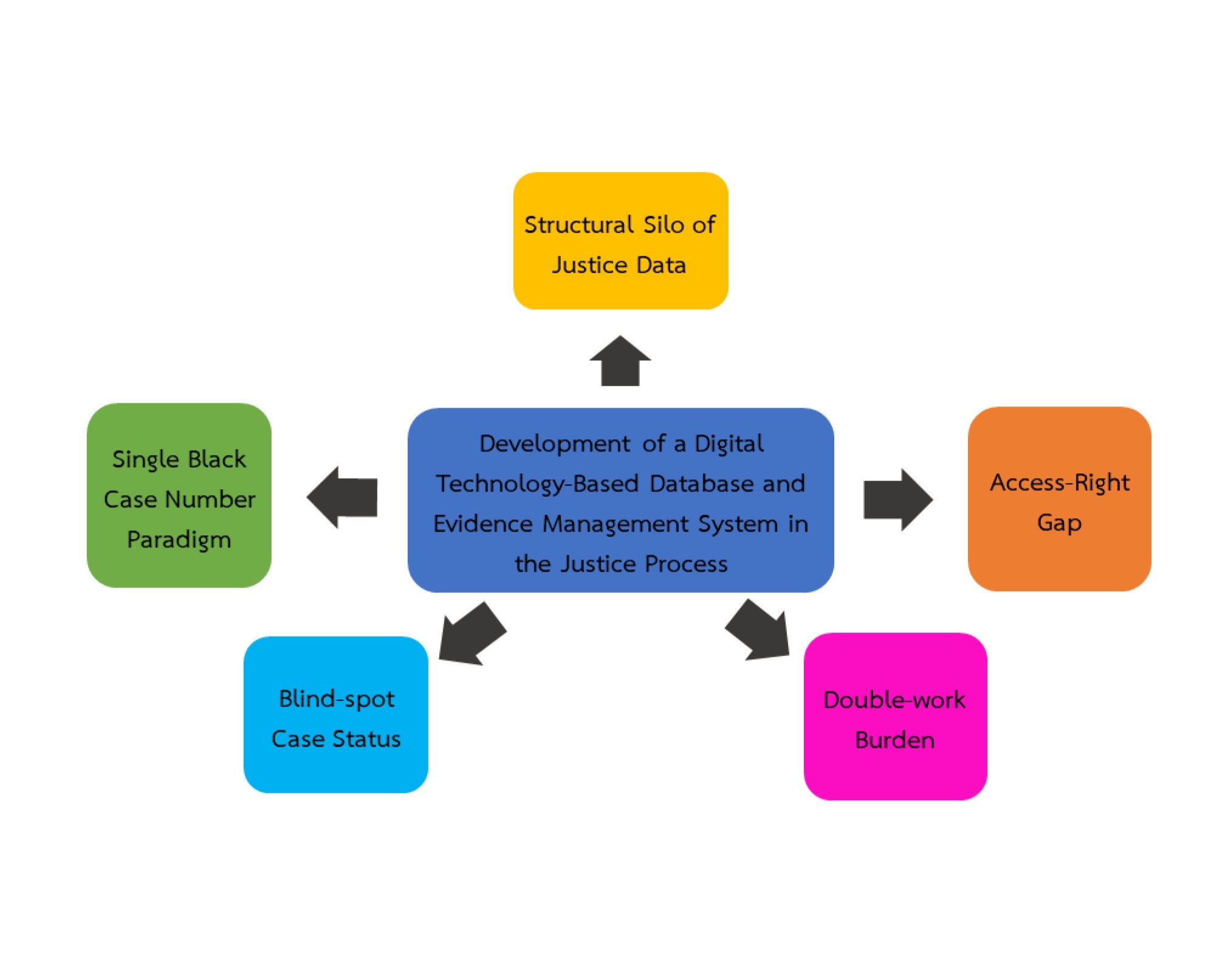Development of a Digital Technology-Based Database and Evidence Management System in the Justice Process: A Case Study of Ubon Ratchathani Province
Main Article Content
Abstract
This research aims (1) to examine the problems and obstacles concerning the data system and evidence storage in the justice process of Ubon Ratchathani Province, and (2) to propose development approaches using digital technologies. The study adopts a qualitative research methodology, utilizing in-depth interviews with 13 key informants from the police, public prosecutors, judiciary, probation department, and digital technology scholars. Data were collected using semi-structured interview guides, approved by a research ethics committee, and analyzed through content analysis and triangulation. The findings reveal two major areas: 1) Key problems and challenges in the provincial data and evidence management systems include: (1) Fragmented data structures and continued reliance on paper-based documentation; (2) Disconnected systems such as AWIS/POLIS, e-Saraban, e-Filing/CIOS, and DOPIS, which require physical transmission of case files and judgments; (3) Limited access to the central data exchange platform, restricted to central agencies, with no shared standard case number system; (4) Lack of real-time case tracking mechanisms; (5) Paper-based file storage imposes burdens on retrieval and timely disposal; and (6) Administrative staff face redundant data entry into both digital and paper systems, causing delays and inefficiencies. 2) Proposed development approaches for a secure and verifiable integrated data system include: (1) A centralized or interoperable database with standardized protocols; (2) Single Sign-On (SSO) with identity verification providers and a unified reference via black-case numbers; (3) Blockchain technology to verify the integrity and auditability of evidence; (4) Role-Based Access Control (RBAC) with audit logging; (5) Open data integration through a provincial-level data exchange center; (6) Artificial Intelligence (AI) to assist in evidence classification and analysis; (7) Encryption aligned with NIST, PDPA and GDPR standards; and (8) Establishing a joint digital infrastructure fund within the justice sector to support progressive budgeting and inter-agency collaboration. Policy recommendations include enacting legislation for a standard case number system, mandating paperless processes, and upgrading the provincial justice data center into a fully integrated hub.
Article Details

This work is licensed under a Creative Commons Attribution-NonCommercial-NoDerivatives 4.0 International License.
References
กานต์ ศรีสุวรรณ. (2564). กระบวนการตรวจพิสูจน์พยานหลักฐานดิจิทัล: การวิเคราะห์เพื่อพัฒนาเชิงนโยบาย. (ศิลปศาสตรดุษฎีบัณฑิต, จุฬาลงกรณ์มหาวิทยาลัย).
ธิติพงศ์ ภิวัฒน์วุฒิกุล. (2561). ปัญหาทางกฎหมายเกี่ยวกับการบริหารจัดการข้อมูล เทคโนโลยีสารสนเทศกระบวนการยุติธรรม. วารสารวิชาการคณะนิติศาสตร์ มหาวิทยาลัยหัวเฉียวเฉลิมพระเกียรติ, 8(2), 66–81.
ยุคลธร เพ็ญโรจน์. (2566). การพัฒนารูปแบบข้อมูลเพื่อเชื่อมโยงระหว่างหน่วยงานในกระบวนการยุติธรรมทางอาญาสำหรับเด็กและเยาวชนของประเทศไทย. วารสารสังคมศาสตร์และวัฒนธรรม, 7(7), 108–119.
สำนักงานการวิจัยแห่งชาติ. (2567). คู่มือนักวิจัย (ฉบับปรับปรุง). กรุงเทพฯ: สำนักงานการวิจัยแห่งชาติ.
สำนักงานกิจการยุติธรรม. (2566). One-Page Concept Paper: การบริหารจัดการข้อมูลประวัติผู้กระทำผิดของกอง ทะเบียนประวัติอาชญากร สำนักงานตำรวจแห่งชาติ. สืบค้นจาก https://www.oja.go.th/wp-content/uploads/2023/04/02_One-Page-Concept-Paper-ยธส.13_กาสะลอง-1.pdf.
สำนักงานประชาสัมพันธ์จังหวัดอุบลราชธานี. (2566). อุบลฯ จัดโครงการ: การรักษาความมั่นคงของชาติและความปลอดภัยของประชาชน การป้องกันและแก้ไขปัญหาอาชญากรรมในชุมชน ประจำปีงบประมาณ พ.ศ. 2566. สืบค้นจาก https://ubonratchathani.prd.go.th/th/content/category/detail/id/33/iid/165568?.
สำนักงานอัยการสูงสุด. (2566). รายงานประจำปี ปี 66 สำนักงานอัยการสูงสุด. สืบค้นจาก https://fliphtml5.com/ccsfj/chxc//.
Flyvbjerg, B. (2006). Five misunderstandings about case-study research. Qualitative Inquiry, 12(2), 219–245.
Janssen, M., & van der Voort, H. (2016). Adaptive governance: Towards a stable, accountable and responsive government. Government Information Quarterly, 33(1), 1–5.
Kettunen, P., & Kallio, J. (2021). Data-driven management in the public sector: Contextual drivers and barriers. Government Information Quarterly, 38(3), 101598.
Lincoln, Y. S., & Guba, E. G. (1985). Naturalistic inquiry. California: Sage Publications.
Organisation for Economic Co-operation and Development (OECD). (2020). The OECD digital government policy framework: Six dimensions of a digital government. Paris: OECD Publishing.
Organisation for Economic Co-operation and Development (OECD). (2024). Towards Effective Governance of Justice Data. Paris: OECD Publishing.
Pérez, C., López, I., & López, F. (2025). Blockchain-Based Evidence and Legal Validity: Reformulating Norms for Decentralized Justice Systems. Rechtsnormen: Journal of Law, 3(2), 180-189.
Simshaw, D. (2024). Interoperable Legal AI for Access to Justice. The Yale Law Journal Forum, 134, 795.
United Nations Office on Drugs and Crime (UNODC). (2021). Digital transformation of the judiciary: Policy approaches and case studies from across the world. Vienna, Austria: United Nations.
United Nations Office on Drugs and Crime (UNODC). (2023). Guidelines for the governance of statistical data in crime and criminal justice systems. Retrieved from https://www.unodc.org/documents/data-and-analysis/statistics/Statistical_guidelines_governance.pdf.
United States Department of Justice, Office of Legal Policy. (2024). Artificial intelligence and criminal justice: Final report. Retrieved from https://www.justice.gov/olp/media/1381796/dl.
Weber, K., Otto, B., & Österle, H. (2009). One size does not fit all---a contingency approach to data governance. Journal of Data and Information Quality, 1(1), 1-27.
Yin, R. K. (2018). Case study research and applications: Design and methods. (6th ed.). Thousand Oaks, C.A.: Sage.

